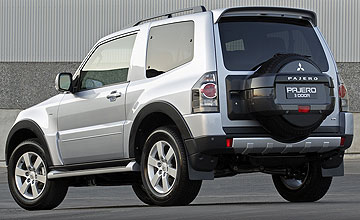BY CHRIS HARRIS | 29th Sep 2006

THOSE folk at Mitsubishi are a resilient lot.
They've been circling the wagons for years now and repeatedly fending off suggestions that the local manufacturer was going to pack up its Tonsley Park factory and end 380 production.
In isolation there are issues facing the company, we all know that and they are not alone in trying to maintain local competitiveness against changing market forces.
But you cannot overlook the fact that they produce some pretty good offerings across a variety of segments.
Look at Colt, Evo IX, Triton, Outlander and you begin to see that Mitsubishi Australia is more than just 380, which in itself is a good car as well.
Now we have the revised NS Pajero and the return of the three-door model that last did service for the brand back in 1999.
We’ve focused our attention on the three-door partly because it’s funky, and partly because it’s a new offering. The five-door is close in character to the old model.
The five-door sits on the same 2780mm wheelbase as the previous model but is 70mm longer, 15mm higher and 10mm narrower. The front and rear tracks have been increased 10mm to 1570mm.
Wading depth has gone up from 600mm to 700mm for both the five and three-door while the ground clearance remains 225mm.
Overall, the three-door is 4385mm long, 1875mm wide, 1880mm high and sits on a 2545mm wheelbase. In scale it fits between a Suzuki Grand Vitara and the Mazda Tribute.
By comparison, the Vitara three-door is smaller while the Pajero X’s proportions are closer to the Tribute, which is 4395mm long, 1800mm wide, 1770mm high and sitting on a 2620mm wheelbase.
Visually, the three-door is a distinctly chubby, chunky affair. The proportions look right despite being 525mm shorter.
Inside the car has the same dashboard and seats as the five-door. The rear seats split fold for extra space and there is a reasonably amount of luggage space with the rear seats in place.
Standard equipment on the X runs to rubber wheel-arch flares, 18-inch alloys, rear spoiler and side steps. According to Mitsubishi “the X will most likely appeal to consumers who have previously purchased three-door sports coupes and are looking for something stylish and unique”.
Like the five-door the X also gets ABS, stability control, Super Select II four-wheel drive, engine brake assist control, traction control and hill-hold assist on the automatic. Dual front airbags are standard while side and curtain airbags are a $1000.
The only glaring omission in the X – shared with the five-door - was the lack of a reach-adjustable steering wheel but comfort levels and visibility are strong points.
The low-set diff-lock button was also too far out of sight to make it a quick and easy affair to switch on.
Like the five-door two engines are offered – the 184kW/329Nm 3.8-litre V6 or 3.2-litre Di-D turbo-diesel – both mated to the Super Select II five-speed automatic.
We spent most of our time in the turbo-diesel, which was smooth, quiet and offered plenty of power and low-speed torque for off-roading.
There are two distinct tunes for the smooth and quiet 3.2-litre Di-D engine.
In the five-speed manual model it develops 118kW at 3800rpm and 381Nm at 2000rpm, while the five-speed automatic develops 125kW at 3800rpm and 358Nm at 2000rpm.
Mitsubishi says the differences are the result of differing engine management and emission systems. The auto also gains a particulate filter to burn off emissions while the manual has twin catalyst converters.
Despite the performance variations, the three-door acquits itself well to any off-road situation.
We preferred the five-speed auto for scrabbling up or down the narrow rutted goat-tracks around Arkaroola Station and it worked a treat with the Di-D.
In low-range the auto offered just the right amount of combined engine and gearbox braking when things got tricky.
The rear locking-differential also allows the car to go that little bit further when the going gets tough.
Like the five-door, the short-wheelbase is impressively strong and cabin quiet. The diesel remained well muted even when revved hard and the up-scale interior looks much better than the previous Pajero.
The suspension is largely the same as the previous five-door. It has revised revised bushes, damper and spring rates with a sharper rack-and-pinion steering.
The front suspension remains a double wishbone, coil spring setup and the rear is a multi-link coil spring arrangement.
The ride, at least on the rough gravel roads on the Flinders Ranges, was impressively smooth, even given the car’s shortened wheelbase. There was little pitching and corrugations were ironed out easily.
In keeping with its off-road mantra, the three-door tips the scales at a not-insubstantial 2175kg to 2310kgs depending on the model.
Driving in mostly low-range off-road mode, the auto returned a respectable 14.9L/100km. Mitsubishi claims the five-speed manual will return 9.2L/100km combined suggesting the diesel will be close to this mark too.
Mitsubishi says the three-door will appeal to city folk. We think so too. With a 10.4m turning circle manoeuvring the wee Pajero through city traffic will be as easy as a small hatchback.
Given its high-up seating position, low-rear window and optional rear parking sensors it will also be easy to park.
We suspect that once all the urban-based professionals cotton on to how good the three-door is, it will conquest owners from upper-end Euro-hatches and some of the less impressive soft-roaders, particularly at the entry $40,990 price point.
Almost all of our initial driving experience involved the unforgiving rugged roads around the Flinders Ranges in South Australia.
We look forward to driving the three-door in an even harsher and more brutal terrain – the city.